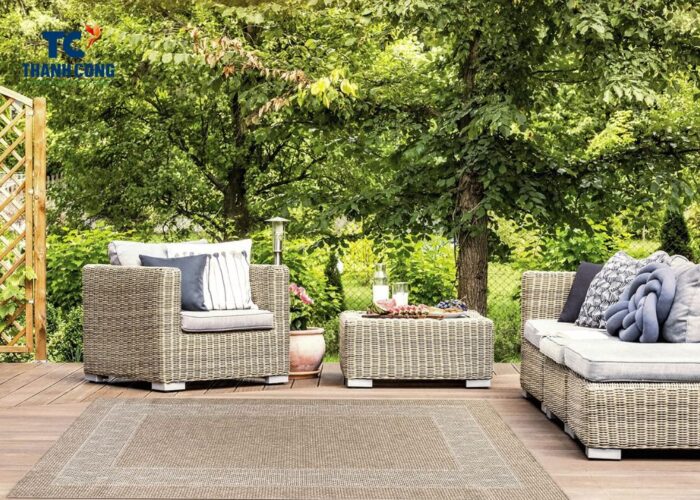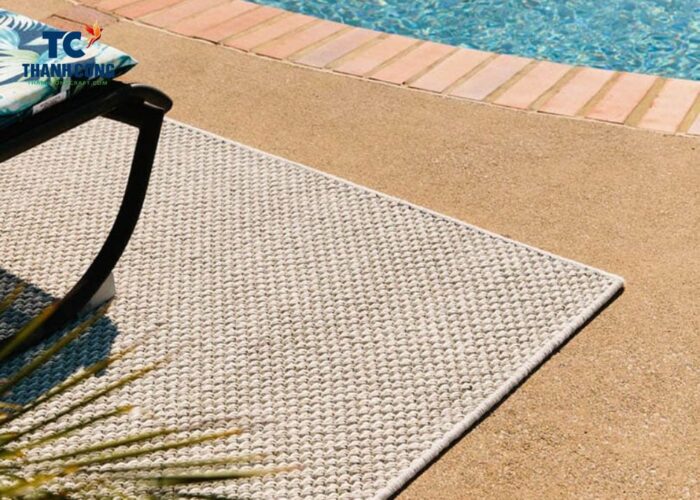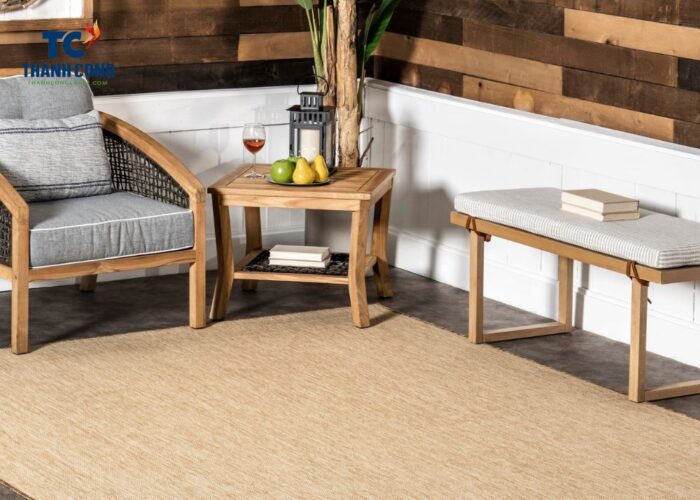Seagrass rug is a type of rug made from seagrass, a kind of plant that lives underwater. Seagrass rug has many advantages such as durability, beauty, environmental friendliness and easy cleaning. However, can a seagrass rug be used outdoors?
This is a question that many people are interested in when they want to decorate their living space with seagrass rugs. In this article, we will answer this question and provide you with some tips and suggestions to use seagrass rug outdoors in the most effective way.
Contents
1. Can A Seagrass Rug be Used Outdoors?
Poly seagrass rugs can be used outdoors because they are waterproof and weather-resistant. However, natural seagrass rugs are not recommended for outdoor use because these natural fibers can absorb water or become brittle in the sun.
Natural seagrass rugs react poorly to moisture, whether that be rainfall or high humidity. The fibers are susceptible to mold and mildew, so moisture aggravates the rug and furthers the decaying process.
With that, these rugs do not take kindly to mud and other wet stains that they may be exposed to outdoors.

1.1 Factors Affecting Seagrass Rug When Leave It Outside
Seagrass is a type of rug made from natural fibers originating from seagrass plants. Seagrass boasts several advantages such as durability, easy cleaning, water resistance, and hypoallergenic properties.
However, there are some drawbacks to using seagrass outdoors, including:
- Color Fading: Seagrass can experience color fading when exposed to prolonged sunlight.
- Mold and Mildew: Without thorough drying after getting wet, seagrass is susceptible to mold and mildew.
- Damage from Sharp Objects: Seagrass can be damaged if cut or torn by sharp objects like fingernails, pet claws, or sharp items.

Therefore, while seagrass rugs can be used outdoors, attention must be paid to climate conditions and proper care. If considering outdoor use, selecting seagrass rugs with UV-resistant features and ensuring they are adequately protected from harsh weather conditions is advisable.
Regular maintenance, such as proper drying after exposure to moisture, also contributes to extending the lifespan of seagrass rugs used in outdoor settings.
1.2 What Happen If A Seagrass Rug Get Wet?
When a natural fiber rug gets wet, several consequences may arise due to the natural characteristics of seagrass fibers:
- Color Change: Seagrass rugs may experience a temporary change in color when they get wet. The fibers can darken or appear mottled until they dry completely.
- Mold and Mildew Growth: Seagrass is susceptible to mold and mildew if it stays damp for an extended period. The growth of these microorganisms can lead to unpleasant odors and compromise the integrity of the rug.
- Weakening of Fibers: Excessive moisture can weaken the seagrass fibers over time, affecting the overall durability and lifespan of the rug.
- Shape Distortion: Prolonged exposure to water can cause seagrass rugs to lose their original shape or develop wrinkles. This is particularly true if the rug is not laid flat and allowed to dry properly.

To mitigate these effects, it’s essential to address any spills or wetness promptly. Thoroughly blot the wet area with a dry cloth or towel to remove excess moisture and allow the rug to air-dry completely.
Additionally, it’s advisable to keep seagrass rugs in well-ventilated areas and avoid placing them in areas prone to high humidity. Regular maintenance and proper drying practices contribute to preserving the quality and appearance of seagrass rugs.
2. FAQs
2.1 Can Seagrass Rugs Get Wet?
Yes, seagrass rugs can get wet. Seagrass is a natural fiber known for its water-resistant properties, making it suitable for areas where spills or exposure to moisture are likely.
However, while seagrass rugs can tolerate some level of moisture, it’s essential to note that prolonged exposure to excessive wetness can lead to potential issues such as color changes, mold, and mildew growth, weakening of fibers, and distortion of shape.
To maintain the longevity and appearance of seagrass rugs, it’s recommended to address spills promptly, ensure proper ventilation, and allow the rug to dry thoroughly after getting wet.
2.2 Are Seagrass Rugs Durable?
Yes, seagrass rugs are known for their durability. Seagrass is a robust and resilient natural fiber that can withstand heavy foot traffic and wear. The fibers are tightly woven, providing strength and stability to the rug.
Seagrass rugs are particularly durable in high-traffic areas, making them a popular choice for both residential and commercial spaces. Additionally, the natural texture and neutral tones of seagrass rugs contribute to their timeless appeal and versatility in various design settings.
Regular maintenance and proper care can further enhance the longevity of seagrass rugs, making them a durable and practical choice for flooring solutions.
2.3 Can You Put Outdoor Rug on Grass?
Yes, you can put an outdoor rug on grass. Outdoor rugs are designed to withstand various weather conditions and are often made from durable materials that can resist moisture, UV rays, and other outdoor elements.
Placing an outdoor rug on grass can be an excellent way to add comfort and style to your outdoor space, such as a patio, deck, or garden.
2.4 Pros And Cons of Seagrass Rugs
However, natural seagrass rugs can be sensitive to water and prolonged exposure to sunlight, and their coarse texture may not be comfortable underfoot. Therefore, polypropylene rugs have emerged as an alternative. These rugs are durable and comfortable for outdoor use but may lack environmental friendliness compared to seagrass.
In summary, seagrass rugs can be used outdoors if properly cared for and shielded from weather elements. They offer numerous advantages such as durability, aesthetic appeal, environmental friendliness, and easy maintenance.
However, seagrass rugs are susceptible to mold and moisture, can fade, and may experience wear and tear when directly exposed to sunlight, rain, or snow. Therefore, it is advisable to choose locations with overhead protection or utilize protective materials to extend the lifespan of seagrass rugs when used outdoors.
If you have any further questions, don’t hesitate to send thanhcongcraft an email us at info@thanhcongcraft.com or message us at WhatsApp: +84967485411. Hope to serve you soon! Best regard!












